 Rough map of the general area around Aughnacloy that I did after returning to Germany, drawn from memory. Some of the key features of the area are identified along with some other points of interest. FP = Firing point, Monica's = Girlfriend of local IRA man Jim "James" Lynagh, M1/M2/M2A = Border crossings. Much of the border in our area was defined by the river Blackwater, a good fishing river with excellent brown trout. "Mike One" was the official border crossing point to the republic, while a number of other crossing points existed such as M2 and M2A to name a couple, these consisted of bridges over the river that had been partially blown up leaving only a small segment of the bridge intact which while not suitable for vehicular traffic was more than ample for anyone on foot.
Rough map of the general area around Aughnacloy that I did after returning to Germany, drawn from memory. Some of the key features of the area are identified along with some other points of interest. FP = Firing point, Monica's = Girlfriend of local IRA man Jim "James" Lynagh, M1/M2/M2A = Border crossings. Much of the border in our area was defined by the river Blackwater, a good fishing river with excellent brown trout. "Mike One" was the official border crossing point to the republic, while a number of other crossing points existed such as M2 and M2A to name a couple, these consisted of bridges over the river that had been partially blown up leaving only a small segment of the bridge intact which while not suitable for vehicular traffic was more than ample for anyone on foot. The main two accomodation blocks within the Army Camp, all two storey affairs with alot of squaddies in a small space, all very cramped. The block on the extreme left of the picture was the offices, intell, briefing rooms, etc,etc. The netting and framework on the roofs of the building was a precaution against rocket and mortar attack, it had been found that such simple methods could prevent the projectile from detonating.
The main two accomodation blocks within the Army Camp, all two storey affairs with alot of squaddies in a small space, all very cramped. The block on the extreme left of the picture was the offices, intell, briefing rooms, etc,etc. The netting and framework on the roofs of the building was a precaution against rocket and mortar attack, it had been found that such simple methods could prevent the projectile from detonating. C-Battery, A Troop at Aughnacloy 1981.
C-Battery, A Troop at Aughnacloy 1981. C-Battery B Troop at Aughnacloy 1981.
C-Battery B Troop at Aughnacloy 1981. Ready for a three day patrol out in the wilds, equipped with an SLR and image intensifier night sight. There were at least two Saracen's at the camp, used ocassionally. Trouble was they made a hell of a noise starting up and running and could be heard miles away. So anyone who was familiar with their distinctive sound could easily tell when they were on the move.
Ready for a three day patrol out in the wilds, equipped with an SLR and image intensifier night sight. There were at least two Saracen's at the camp, used ocassionally. Trouble was they made a hell of a noise starting up and running and could be heard miles away. So anyone who was familiar with their distinctive sound could easily tell when they were on the move. Aughnacloy 1981, Nick Young passes a soft target. Soft target was a term we applied to anyone who was non-military, civvies, police and the like, and reflected their potential softness as a target for the terrorists. The members of the RUC did a difficult task, and didn't enjoy the biggest benefit we had. After our tour was over, we went home. They on the other hand did their turn of duty and went home, but remained in the firing line.
Aughnacloy 1981, Nick Young passes a soft target. Soft target was a term we applied to anyone who was non-military, civvies, police and the like, and reflected their potential softness as a target for the terrorists. The members of the RUC did a difficult task, and didn't enjoy the biggest benefit we had. After our tour was over, we went home. They on the other hand did their turn of duty and went home, but remained in the firing line.
----------------------------------------------------
Aughnacloy
 View from immediately outside the Army camp looking up the B128 towards Moore Street in Aughnacloy. The Church at the top of the street at the junction with Moore Street was the first hazard upon exiting the main gate of the camp, a sniper positioned in the bell tower would have a clear field of fire covering much of the street we came out into. So it was move fast, take up a firing position covering one direction or another, wait for the next lads to do the same covering your next move up the street, and so on leapfrogging your way up the street.
View from immediately outside the Army camp looking up the B128 towards Moore Street in Aughnacloy. The Church at the top of the street at the junction with Moore Street was the first hazard upon exiting the main gate of the camp, a sniper positioned in the bell tower would have a clear field of fire covering much of the street we came out into. So it was move fast, take up a firing position covering one direction or another, wait for the next lads to do the same covering your next move up the street, and so on leapfrogging your way up the street. Night time view looking from the PVCP up the (A5) towards Moore Street in Aughnacloy.
Night time view looking from the PVCP up the (A5) towards Moore Street in Aughnacloy. "Geordie" Brown doing a spot vehicle check on from the looks of the bungalow Mill Street (A5) which is the main road down to the PVCP(M1).
"Geordie" Brown doing a spot vehicle check on from the looks of the bungalow Mill Street (A5) which is the main road down to the PVCP(M1). View looking from the PVCP up the (A5) towards Moore Street in Aughnacloy.
View looking from the PVCP up the (A5) towards Moore Street in Aughnacloy. Members of C-bty calling in at the Royal Ulster Constabulary(RUC) police station on the Dungannon Road(B35) at Aughnacloy.
Members of C-bty calling in at the Royal Ulster Constabulary(RUC) police station on the Dungannon Road(B35) at Aughnacloy.
----------------------------------------------------
PCVP
 Document check on a vehicle passing through the Permanent Vehicle Check Point(PVCP) at Aughnacloy on the border with the republic. Known to us as "Mike One"(M1), it was situated on the Monaghan Road(A5) just on the outskirts of Aughnacloy on the main road to the border.
Document check on a vehicle passing through the Permanent Vehicle Check Point(PVCP) at Aughnacloy on the border with the republic. Known to us as "Mike One"(M1), it was situated on the Monaghan Road(A5) just on the outskirts of Aughnacloy on the main road to the border. Shot of the interior of "Mike One", members of C-bty and the RUC checking vehicles as they pass through. The check point was surrounded by breeze block walls and screens to block the view of the interior to potential snipers. It wasn't unknown for the Paddie's to have a go at the check point even if there was little chance of hitting anything, but merely to let us know they were still there. An IRA firing position frequently used was situated in the hedgeline on top of a hill just across the border, they would turn up, rattle off a load of rounds stirring up a bit of a hornets nest and then retire. Our side might return fire, but wild indiscriminate firing into the republic was not condoned. The fact that elements of the IRA were active would be conveyed to the Garda, but usually by the time they turned up the trail had gone cold and everyone had gone to ground.
Shot of the interior of "Mike One", members of C-bty and the RUC checking vehicles as they pass through. The check point was surrounded by breeze block walls and screens to block the view of the interior to potential snipers. It wasn't unknown for the Paddie's to have a go at the check point even if there was little chance of hitting anything, but merely to let us know they were still there. An IRA firing position frequently used was situated in the hedgeline on top of a hill just across the border, they would turn up, rattle off a load of rounds stirring up a bit of a hornets nest and then retire. Our side might return fire, but wild indiscriminate firing into the republic was not condoned. The fact that elements of the IRA were active would be conveyed to the Garda, but usually by the time they turned up the trail had gone cold and everyone had gone to ground. A view of the PCVP(M1) in more recent times, not a lot changes.
A view of the PCVP(M1) in more recent times, not a lot changes. Vehicle and its occupants being checked at the PCVP, the tower behind the car is one of the machine gun posts protecting the PCVP. Field of fire was across open farmland towards the border.
Vehicle and its occupants being checked at the PCVP, the tower behind the car is one of the machine gun posts protecting the PCVP. Field of fire was across open farmland towards the border. Geoff Gartland on the Clansman radio set at the PCVP, if there hadn't been an extensive network of relay stations across the province, I wonder how it would have performed?
Geoff Gartland on the Clansman radio set at the PCVP, if there hadn't been an extensive network of relay stations across the province, I wonder how it would have performed?
The one message that no one really wanted to hear over the radio was "Contact! Wait Out!", it meant that someone was under fire. If you were not directly involved in it, it meant anxious minute's waiting to find out who and where, and more importantly were there casualties. No one wanted one of their buddies to cop a packet.
 It was normal practice to photograph vehicles and their occupants as the passed through the PVCP(M1), not all the Paddies were happy with such attention and tried to avoid you getting a good mugshot of them. Sometimes this may have been for perfectly the innocent reason that they didn't like their picture being taken without their consent, or it may have been to conceal the fact that they were a known IRA suspect, sympathiser or had known associations with such. Disguises were not unkown of and were frequently used as a means to slip through.
It was normal practice to photograph vehicles and their occupants as the passed through the PVCP(M1), not all the Paddies were happy with such attention and tried to avoid you getting a good mugshot of them. Sometimes this may have been for perfectly the innocent reason that they didn't like their picture being taken without their consent, or it may have been to conceal the fact that they were a known IRA suspect, sympathiser or had known associations with such. Disguises were not unkown of and were frequently used as a means to slip through. -----------------------------------------------------
A moment's fun amongst the serious stuff.
 CSE Show. Simon Turner doing what he does best.
CSE Show. Simon Turner doing what he does best. CSE Show. "Geordie" Brown and Chris Wilson join the act.
CSE Show. "Geordie" Brown and Chris Wilson join the act. CSE Show. No need to ask what most of us squaddies were thinking after 3 months on Northern Ireland.
CSE Show. No need to ask what most of us squaddies were thinking after 3 months on Northern Ireland. The CSE Show. The star attraction of the show, the stripper's.
The CSE Show. The star attraction of the show, the stripper's.-----------------------------------------------------
3 day Patrols
 Frankie and Nick relaxing at the loading bay. Aughnacloy 81. I dont think any of us ever gave much thought to political rights or wrongs of the situation in Paddyland, such notions have little place in a soldier's life. We may have thought that some of those higher up hadn't a clue on what they were doing, but we were soldiers and we followed order's whatever they may be. We also did our job willingly because we wanted all our mates to come home, and the surest way of doing that was to do your duty to the best of your ability, family is family and the unit was our family.
Frankie and Nick relaxing at the loading bay. Aughnacloy 81. I dont think any of us ever gave much thought to political rights or wrongs of the situation in Paddyland, such notions have little place in a soldier's life. We may have thought that some of those higher up hadn't a clue on what they were doing, but we were soldiers and we followed order's whatever they may be. We also did our job willingly because we wanted all our mates to come home, and the surest way of doing that was to do your duty to the best of your ability, family is family and the unit was our family. Whats so funny? Someone told a joke?. Aughnacloy 81. The 3 day patrol could be a nice little outing, but then again it could equally be a very unpleasant and uncomfortable outing depending upon the Irish weather which could be fickle at times. I remember one instance when the weather took a particularly bad and one bloke went down with exposure, the weather was against a helicopter pickup so an unmarked van was dispatched to pick him and take him in for medical treatment. Everyone in the unit was accustomed to driving in Germany on the other side of the road, and it took awhile to adapt back to the left. I guess the driver of the van was thinking of his colleague and forgot where he was for a moment on the way back, and ran head on into another van coming the other way on the right side of the road. The exposure casualty apparently suffered a further broken arm and collar bone as a result of the crash, as I remember it.
Whats so funny? Someone told a joke?. Aughnacloy 81. The 3 day patrol could be a nice little outing, but then again it could equally be a very unpleasant and uncomfortable outing depending upon the Irish weather which could be fickle at times. I remember one instance when the weather took a particularly bad and one bloke went down with exposure, the weather was against a helicopter pickup so an unmarked van was dispatched to pick him and take him in for medical treatment. Everyone in the unit was accustomed to driving in Germany on the other side of the road, and it took awhile to adapt back to the left. I guess the driver of the van was thinking of his colleague and forgot where he was for a moment on the way back, and ran head on into another van coming the other way on the right side of the road. The exposure casualty apparently suffered a further broken arm and collar bone as a result of the crash, as I remember it. Who's forgotten the Cam cream then?. Aughnacloy 81. One of the things we would quite often do on a 3 day patrol would be to get into a postion overlooking one of the unofficial border crossing points, could often one of us could be near enough right on top of it. It generally worked out as 4 hours on, 1 hour off, it was a regime that could tell on you at times more than you might think and certainly resulted in some of us nodding off when they shouldnt have. I know, as I did nod off meself on one ocassion, and it wasn't for want of not trying to stay awake. I fought that battle hard to stay awake and lost that battle on one ocassion, so I knew how hard it could be and wasn't surprised to hear of others doing similar. Though a few didn't seem to attempt to fight that battle very hard. It was a battle everyone of us has had to fight at times.
Who's forgotten the Cam cream then?. Aughnacloy 81. One of the things we would quite often do on a 3 day patrol would be to get into a postion overlooking one of the unofficial border crossing points, could often one of us could be near enough right on top of it. It generally worked out as 4 hours on, 1 hour off, it was a regime that could tell on you at times more than you might think and certainly resulted in some of us nodding off when they shouldnt have. I know, as I did nod off meself on one ocassion, and it wasn't for want of not trying to stay awake. I fought that battle hard to stay awake and lost that battle on one ocassion, so I knew how hard it could be and wasn't surprised to hear of others doing similar. Though a few didn't seem to attempt to fight that battle very hard. It was a battle everyone of us has had to fight at times.
Conversely there were other instances were glaring omissions were made which could have been equally dire, on one 3 day patrol we set up a camp for the night in some woods and half of us went off to do spot vehicle checks on roads in the area. We spent the evening and a good part of the night doing vehicle checks on the roads in the surrounding area before heading back to where the rest of the patrol were camped out. By this time it was around 2300-2330, and we were very surprised to be able to walk right into the middle of the camp and find everyone soundly asleep, not so much as one sentry had been set out! Not so much as one challenge to our approach to the camp, only when our Bombardier started kicking a few of the inert bodies did they become aware of us. It wasn't unknown for the Provo's to come over the border in force doing in effect their own version of a patrol, had one of these entered that camp as we did, they could have wiped out the five sleeping soldiers without a shot fired and captured all their weapons and equipment.
 The best part of the tour, the three day patrol. Aughnacloy 81. Either our CO or BSM had the idea, that the best way to stop the IRA from operating freely in our area was to have as many bodies out on the ground as possible. So the majority of C-Bty spent their tour on three day patrols, patrolling, surveillance on known IRA suspects and sympathisers, snap vehicle check points, checking on soft targets and so on. As a result you might have 1-2 days at most in camp between patrols. It was a strategy that worked well, as it did limit and hamper the IRA from operating freely. lots of us blokes out on the ground and the extensive use of helicopters to pick us up at one point and drop us off at another point, meant that even if one of their dicker's(a person who observed and reported back any sighting of us etc) gave our position as being at a specific point or area they couldn't rely on that for long and they had no way of telling were we might resurface until one our their dicker's revealed that.
The best part of the tour, the three day patrol. Aughnacloy 81. Either our CO or BSM had the idea, that the best way to stop the IRA from operating freely in our area was to have as many bodies out on the ground as possible. So the majority of C-Bty spent their tour on three day patrols, patrolling, surveillance on known IRA suspects and sympathisers, snap vehicle check points, checking on soft targets and so on. As a result you might have 1-2 days at most in camp between patrols. It was a strategy that worked well, as it did limit and hamper the IRA from operating freely. lots of us blokes out on the ground and the extensive use of helicopters to pick us up at one point and drop us off at another point, meant that even if one of their dicker's(a person who observed and reported back any sighting of us etc) gave our position as being at a specific point or area they couldn't rely on that for long and they had no way of telling were we might resurface until one our their dicker's revealed that.
The helicopters were either manned by RAF or Army Air Corps personel and there were distinct differences between the two service's. The RAF tended to be all business like, fly in pick you up, fly high, drop you off. Where as many of the Army Air Corps boys liked to have a bit of fun, they'd pick you up and fly nap-of-the-earth all the way to the drop off point. I can remember many a trip looking out of a Lynx doorway straight down the trunk of a tree to the ground. All I could conclude from it all was that maybe the RAF boys never felt a need to show off like the Army Air Corps boys did, they could do all that fancy nap-of-the-earth stuff but didnt need to, thats not saying one service was better than the other, just that perhaps one perhaps revelled in it a tad more than the other did.
While helicopters where a frequent method used for moving bodies from point A to point B, they were not the sole means. Unmarked civilian vans were used regularly, I don't think anyone found them particularly pleasant, sitting in the back all shut in, not being able to see out. No one liked riding around blind, and I think everyone was always glad when the journey was complete and we were able to get out of the bleeder's. Primed and ready for action?. Augnacloy 81. Ocassionally we had some event to break the monotony of three days patrols, one such event was a big flap that developed following an incident up north. A certain "Taesy Weasey" McDonald had been involved in a shoot out and had been nicked by a bullet, intell reckoned he would make a run for the Republic and had it on good authority that one of the most likely routes would be through our area via the PVCP. So the intended course of action was that the suspect vehicle would be allowed to pass through the PCVP normally if it did come that way, and it would then be challenged and stopped again between the PCVP and the actual border. An ambush was set up and put into place, I didn't think we had that many GPMG's, it seemed like everyone in the ambush had one.
Primed and ready for action?. Augnacloy 81. Ocassionally we had some event to break the monotony of three days patrols, one such event was a big flap that developed following an incident up north. A certain "Taesy Weasey" McDonald had been involved in a shoot out and had been nicked by a bullet, intell reckoned he would make a run for the Republic and had it on good authority that one of the most likely routes would be through our area via the PVCP. So the intended course of action was that the suspect vehicle would be allowed to pass through the PCVP normally if it did come that way, and it would then be challenged and stopped again between the PCVP and the actual border. An ambush was set up and put into place, I didn't think we had that many GPMG's, it seemed like everyone in the ambush had one.
Anyway the subject of all this activity never showed, he went by an alternative route. Had he come our way, and had they tried to make something of it upon being stopped the second time between the PCVP and the border, then there's no doubt in my mind that they would have literally been cut to ribbons based on the amount of firepower that had been put into the ambush. Tony gets to play with the M79 40mm Grenade Launcher, when fired it gave a rather disappointing sort of "POP", but when the projectile hit it resulted in a respectable BANG! As I remember it, I beleive the allocation was 1 per patrol. Certainly preferable to lugging a GPMG everywhere.
Tony gets to play with the M79 40mm Grenade Launcher, when fired it gave a rather disappointing sort of "POP", but when the projectile hit it resulted in a respectable BANG! As I remember it, I beleive the allocation was 1 per patrol. Certainly preferable to lugging a GPMG everywhere.
On ocassions when they had the opportunity, the likes of the BSM would come out on a 3 day patrol with the lads. Most of the time they were cooped up in a office buried under paperwork etc, so an ocassional escape was a welcome thing for them. As to whether it was a welcome thing for whoever's patrol they decided to tag along with is another matter. It was certainly an opportunity for a bit of payback, after a time you got to know the areas where you patrolled intimately, you knew where the hardest going was, the thickest hedges, the deepest and widest ditches, the boggiest ground and you would incorporate a good selection of it into your route. The hope being that they would find it hard going and that they wouldn't want to come along on one of our little jaunts again in the near future. Do not feed the animals, Rocky Hudson, Chink Hemmings, Taff Appleby, Geoff Gartland. A crucial part of 3 day patrols was checking on soft targets in our area, these could be either members of the RUC or UDR who lived on farms out near the border. It was reassuring for them to see us turn up every now and then to check on their wellbeing as some of them lived perilously close to the border. A key odjective in the strategy developed by East Tyrone Brigade Commander Jim "James" Lynagh was to sanitize such border areas of such soft targets and create liberated areas or zones where the inhibitants were all 100% republican and behind the cause. It was our job to ensure that never happened.
Do not feed the animals, Rocky Hudson, Chink Hemmings, Taff Appleby, Geoff Gartland. A crucial part of 3 day patrols was checking on soft targets in our area, these could be either members of the RUC or UDR who lived on farms out near the border. It was reassuring for them to see us turn up every now and then to check on their wellbeing as some of them lived perilously close to the border. A key odjective in the strategy developed by East Tyrone Brigade Commander Jim "James" Lynagh was to sanitize such border areas of such soft targets and create liberated areas or zones where the inhibitants were all 100% republican and behind the cause. It was our job to ensure that never happened.
Some of these soft targets were always a good pitstop, you could always get a cuppa and a few biscuits if you turned up, some would even offer the use of farm outbuildings for the night. A welcome offer in bad weather, and I guess they slept a tad easier for at least one night knowing we were very close at hand. One stop was I think the Eagleson's, they had a daughter, a young slip of a girl and some of our lads were always keen to try their chat up lines when they stopped by.
 Lippy, Frankie and Nick. Aughnacloy 81. Each patrol had at least one individual designated as lead scout, they would know the key points where they had to get to, and it was pretty much up to them to determine the route in between. You could let the natural features within the terrain determine your route for you, a course not to be recommended. A farm track with high hedges on either side could channel you down to a gate, a gate you say, no problem, but when you climb the gate a large bomb goes off. Not recommended. Instead you'd choose a route that avoided such obviously easy choices, picking the harder way through hedges, across ditches and so on. Sometimes you would come to an obstacle on your route that you couldn't easily avoid, a bridge over a river for example, you may even be required to check it out as a patrol objective. Such things could be required, routes frequently used by security vehicles needed to be checked regularly, bridges, culverts all needed to be checked. If this wasn't done, sooner or later you might get a security vehicle crossing a bridge or culvert and a 1,000lbs of Semtex goes off.
Lippy, Frankie and Nick. Aughnacloy 81. Each patrol had at least one individual designated as lead scout, they would know the key points where they had to get to, and it was pretty much up to them to determine the route in between. You could let the natural features within the terrain determine your route for you, a course not to be recommended. A farm track with high hedges on either side could channel you down to a gate, a gate you say, no problem, but when you climb the gate a large bomb goes off. Not recommended. Instead you'd choose a route that avoided such obviously easy choices, picking the harder way through hedges, across ditches and so on. Sometimes you would come to an obstacle on your route that you couldn't easily avoid, a bridge over a river for example, you may even be required to check it out as a patrol objective. Such things could be required, routes frequently used by security vehicles needed to be checked regularly, bridges, culverts all needed to be checked. If this wasn't done, sooner or later you might get a security vehicle crossing a bridge or culvert and a 1,000lbs of Semtex goes off.
The usual practice was the patrol would approach to about 200yds from such an obstacle and go to ground, the lead scout would then circle the obstacle about 200 yds out looking all the time for signs that there might be a command wire buried or anything equally suspicious, Lead scouts were also equiped with a device code named "Joker", it was supposed to give you a indication of the presence of radio controlled bombs. How good it was at detecting them I cant say, but I can say when you were circling you listened with an intensity that was unbeleiveable. The lead scout would eventually do a 360 circle around the obstacle, coming back to the point where he started from, at this point there was only one step left for him to do before he could reasonably say it was clear. That was to go up to the obstacle and check it out directly, for a bridge or culvert that meant looking under or in it, and it would be a tense few moments until you looked. If there was nothing there, sweet relief would wash over you like a wave. If there had ever been something there, I think the first thing that would have popped into one's head would have been "Oh Shit"
Equipment
 7.62mm Self Loading Rifle (SLR)
7.62mm Self Loading Rifle (SLR) 7.62mm General Purpose Machine Gun (GPMG), also known as the "Jimpie"
7.62mm General Purpose Machine Gun (GPMG), also known as the "Jimpie" 7.62mm General Purpose Machine Gun (GPMG), also known as the "Jimpie"
7.62mm General Purpose Machine Gun (GPMG), also known as the "Jimpie" Sterling 9mm Submachine gun
Sterling 9mm Submachine gun Sterling 9mm Sub-machine gun
Sterling 9mm Sub-machine gun Browning 9mm pistol
Browning 9mm pistol
M79 grenade launcher, with ladder sight in 'ready' position.
Same M79 launcher, with various types of 40mm rounds (Illum, HE-FRAG, buckshot, 22lr multi-barrel adaptor etc).
M79 launcher, partially opened for reloading.
Their's
 AR-18 Amalite rifle
AR-18 Amalite rifle
M1 Garand rifle
 AK 47 Kalashnikov
AK 47 Kalashnikov M1 Carbine
M1 Carbine Mk10 Mortar
Mk10 Mortar----------------------------------------------------------------------------

Jim "James" Lynagh one of our top targets at the time.
One of fourteen children, Lynagh was born and raised in County Monaghan in the Republic of Ireland. He joined the IRA in the early 1970s. In December 1973 he was badly injured in a premature bomb explosion, arrested, and spent five years in Long Kesh prison. While in jail he studied and became a great admirer of Mao Zedong. After his release from prison in 1979 Lynagh was elected as a Sinn Féin councillor for Monaghan, and held this position when he was killed.
East Tyrone Brigade
After his release from prison Lynagh became active in the IRA again, serving with the Provisional IRA East Tyrone Brigade. He quickly became a unit commander and gradually built up his ruthless reputation. After a series of Loyalist attacks against Nationalist politicians in late 1980 and early 1981 Lynagh was suspected of involvement with an attack on the Stronge estate near Middletown. The IRA killed the retired Ulster Unionist Stormont speaker, Sir Norman Stronge, and his son James, before burning down their mansion, Tynan Abbey, and shooting their way through a police cordon.
Lynagh was known as “The Executioner” by the Royal Ulster Constabulary (RUC). He was picked up and interrogated many times by the Gardaí in Monaghan but was never charged. During this time he devised a Maoist military strategy adapted to Irish conditions aimed at escalating the war against British forces. The plan envisaged the destruction of police and British Army bases in parts of Northern Ireland in order to create liberated areas under IRA control. In 1984 he started cooperating with Pádraig McKearney who shared his views. The strategy began materializing with the destruction of RUC police stations in Ballygawley in December 1985 (where two RUC officers were killed), and in The Birches in August 1986. Jim Lynagh is believed to have been responsible for 28 killings.[citation needed] The Irish police and the RUC said he was one of the hardest men they ever interrogated.
Death
Lynagh was killed in an ambush by the Special Air Service on 8 May 1987 during an IRA attack on Loughgall RUC police station, his third attack on isolated rural police stations. Lynagh's men detonated a 200 lb bomb and engaged in a fire-fight with the security services. Lynagh and the seven other members of the IRA team, who were killed became known as the "Loughgall Martyrs" to Irish Republicans.
Lynagh was buried in Monaghan Town following an incident where Garda Special Branch officers were attacked by a crowd of mourners.
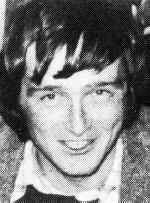
Pádraig McKearney
McKearney was raised in Moy, County Tyrone in a staunchly Irish republican family. Both his grandfathers had fought in the Irish Republican Army in the Irish War of Independence, his maternal grandfather in the south County Roscommon, and his paternal grandfather in east Tyrone.
Pádraig McKearney was educated at local primary schools in Collegeland and Moy, and went on to St. Patrick's Academy in Dungannon. However his education was interrupted by the outbreak of the conflict known as The Troubles. He joined the Provisional IRA and left school after he was first arrested in 1972 on charges of blowing up the post office in Moy. He spent six weeks on remand, but was released due to insufficient evidence being assembled.
In December 1973, he was arrested again and later sentenced to seven years for possession of a rifle. He was imprisoned in Long Kesh and later in Magilligan prison. During this period of incarceration his younger brother Seán, also an IRA volunteer, was killed on active service on 13 May 1974. Pádraig was released in 1977 but was sentenced to 14 years in August 1980 after being caught by the SAS with a loaded sten gun along with fellow IRA man Gerard O'Callaghan. That same year Pádraig's older brother Tommy, who was sentenced to life imprisonment, nearly died on hunger strike after refusing food for 53 days.
On 25 September 1983 McKearney took part in the Maze Prison escape along with 37 other prisoners. At the beginning of 1984 he returned on active service in his native east Tyrone with the Provisional IRA East Tyrone Brigade. He advocated the commencement of the "third phase" of the armed struggle, the 'strategic defensive', in which the Royal Ulster Constabulary, Ulster Defence Regiment and British Army would be denied all support in selected areas following repeated attacks on their bases1. His views were very close to those of Jim Lynagh, an IRA commander from County Monaghan, who devised a Maoist guerrilla strategy adapted to Irish conditions with the intent of creating liberated zones.
In 1985 Patrick Kelly became commander of the Provisional IRA East Tyrone Brigade and it was under his leadership that this strategy started becoming reality. Secluded Royal Ulster Constabulary (RUC) bases were attacked and destroyed and building contractors who tried to repair them were targeted and sometimes killed. Prime examples of this policy were the destructions of Ballygawley RUC barracks in December 1985 and The Birches RUC barracks in August 1986. Padraig McKearney was a key architect in many of these attacks and he soon became one of the most experienced guerrilla fighters in the IRA.
McKearney was killed in an ambush by the SAS on 8 May 1987 during an attack on Loughgall RUC barracks which also claimed the lives of seven of his comrades: Jim Lynagh, Patrick Kelly, Declan Arthurs, Seamus Donnelly, Tony Gormley, Eugene Kelly, and Gerry O'Callaghan. He was buried in his hometown of Moy, 13 years to the day after his brother Sean died on IRA active service.

Patrick Joseph Kelly
Background
The oldest child in a family of five, Kelly was born in the largely Protestant town of Carrickfergus, however he was raised and lived in Dungannon, a rural market town in County Tyrone, in a family with a long tradition of Irish republicanism.
Paramilitary activities
Kelly became a member of the Provisional Irish Republican Army at the beginning of the 1970s and gradually became one of the most experienced volunteers in Tyrone.
McGurk supergrass trial
He was arrested in February 1982 on the word of a supergrass called Patrick McGurk but was released in October 1983 due to lack of evidence after a trial that lasted fifteen minutes.
Brigade commader
In 1985, Kelly was appointed brigade commander in East Tyrone and began developing tactics for attacking secluded Royal Ulster Constabulary bases in his area. Under his leadership the East Tyrone Brigade became the most active IRA unit in Northern Ireland.
IRA Army Convention
In 1986, Kelly attended the IRA Army Convention. At the convention the main topic of discussion was the principle of abstentionism. Gerry Adams and others argued the abstentionist rule should be dropped and the Provisional movement should become involved in constitutional politics. Kelly voted against dropping the rule and a rift with the majority of the IRA Army Council ensued.
Loughall
Patrick Kelly was killed in an ambush by the SAS on 8 May 1987 during an attack on Loughgall RUC barracks which also claimed the lives of seven of his comrades: Pádraig McKearney, Declan Arthurs, Seamus Donnelly, Tony Gormley, Eugene Kelly, Jim Lynagh, and Gerard O'Callaghan. Kelly's funeral in Dungannon was one of the largest in Tyrone during The Troubles.
Burial
Kelly was buried in Edendork cemetery, two miles from his home in Dungannon.
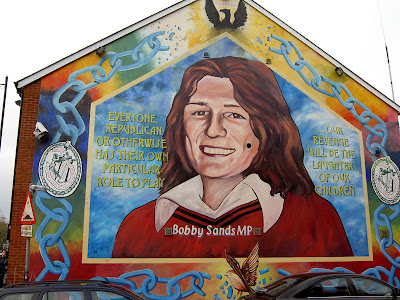
"Bobby" Sands
(included here decause when he died his funeral procession passed through our area as he had relations in the area(a sister I believe), and everyone was sweating that something might kick off as a result)
Family and early life
Sands was born into a Catholic family in Abbots Cross, Newtownabbey, County Antrim, Northern Ireland, and lived there until 1960 and then moved to Rathcoole, Newtownabbey. His first sister, Marcella, was born in April 1955 and second sister, Bernadette, in November 1958. His parents, John and Rosaleen, had another son, John, in 1962. Sands' family had moved due to intimidation by loyalists. On leaving school, he became an apprentice coach-builder until he was forced out at gunpoint by loyalists. In June 1972, at the age of 18, his family moved to the Twinbrook housing estate.
IRA activity
In 1972, the year of the Troubles with the highest death toll, he joined the IRA. In October of that year, Sands was arrested and charged with possession of four handguns which were found in the house in which he was staying. In April 1973 he was sentenced to five years' imprisonment.
On his release in 1976, he returned to his family in Twinbrook in west Belfast, and resumed his active role in the IRA's campaign. He was charged with involvement in the October 1976 bombing of the Balmoral Furniture Company in Dunmurry, although he was never convicted of this bombing, and at the trial the judge said there was no evidence to support the assertion that he had taken part in it. After the bombing, Sands and at least five others in the bomb team were allegedly involved in a gun battle with the police, although he was also never convicted of this for lack of evidence. Abandoning two of their wounded friends, Seamus Martin and Gabriel Corbett, Sands with Joe McDonnell, Seamus Finucane and Sean Lavery tried to escape in a car, but were caught. One of the revolvers used in the attack was found in the car in which Sands was travelling.
His trial in September 1977 saw him convicted of possession of firearms (the revolver from which bullets had been fired at the police after the bombing), and Sands was sentenced to 14 years' imprisonment.
Prisoner
He served his prison term at HM Prison Maze, also known as Long Kesh. After internment a series of buildings known from their floor plans as 'H-Blocks' were built to make the prison suitable for the large number of inmates belonging to paramilitary organisations; each block contained members of the same organisation.
In prison, Sands became a writer both of journalism and poetry which was published in the Irish republican newspaper An Phoblacht. In late 1980 Sands was chosen as Officer Commanding of the IRA prisoners in Long Kesh, succeeding Brendan Hughes who was participating in the first hunger strike.
Political status protests
Republican prisoners had organised a series of protests seeking to regain their previous Special Category Status and not be subject to ordinary prison regulations. This started with the "blanket protest" in 1976, when the prisoners refused to wear uniform and wore blankets instead. Attempts to break the protest by brutalisation of prisoners saw the escalation to the "dirty protest" of 1978 when repeated beatings during "slop-out" led to prisoners living in squalor by smearing excrement on the walls. There had been an earlier hunger strike in Autumn 1980, which had ended when the British Government appeared to concede the prisoners' demands. When that strike was over, the Government reverted to its previous stance.
Hunger strike
The 1981 Irish hunger strike started with Sands refusing food on 1 March, 1981. Sands decided that other prisoners should join the strike at staggered intervals in order to maximise publicity with prisoners steadily deteriorating successively over several months.
The hunger strike centred around "Five Demands":
The right not to wear a prison uniform;
The right not to do prison work;
The right of free association with other prisoners, and to organise educational and recreational pursuits;
The right to one visit, one letter and one parcel per week;
Full restoration of remission lost through the protest.
The significance of the hunger strike was the prisoners' aim of being declared as political prisoners (or prisoners of war) and not to be classed as criminals. However, the primary purpose of the exercise was often regarded as an attempt to gain international publicity rather than political prisoner status.
Election
Shortly after the beginning of the strike, Frank Maguire, the Independent Republican MP for Fermanagh and South Tyrone (UK Parliament constituency) died of a heart attack suddenly and precipitated a by-election.
The sudden vacancy in a seat with a small Roman Catholic majority was a valuable opportunity for Sands' supporters to unite the nationalist community behind their campaign. Pressure not to split the vote led other nationalist parties, notably the Social Democratic and Labour Party, to withdraw and Sands was nominated on the label "Anti H-Block / Armagh Political Prisoner". After a highly polarised campaign, Sands narrowly won the seat on 9 April, 1981, with 30,493 votes to 29,046 for the Ulster Unionist Party candidate Harry West, incidentally also becoming the youngest MP at the time.
Following Sands' success the Government introduced to Parliament the Representation of the People Act 1981 which prevents convicted prisoners serving jail terms of more than one year in either the UK or the Republic of Ireland, or unlawfully at large when they should be serving such a sentence, from being nominated as candidates in U.K. elections. This law was quickly introduced so as to prevent the other hunger strikers from being nominated to his vacant seat after his death.
Death
Three weeks later, Sands died in the prison hospital after 66 days of hunger-striking, aged 27. The announcement of his death prompted several days of riots in nationalist areas of Northern Ireland. A milkman and his son, Eric and Desmond Guiney, died as a result of injuries sustained when their milk float crashed after being stoned by rioters in a predominantly nationalist area of north Belfast. Over 100,000 people lined the route of Sands' funeral.[24] Sands was a Member of the Westminster Parliament for twenty-five days, though he never took his seat or oath.
In response to a question in the House of Commons on 5 May 1981, Prime Minister Margaret Thatcher said, "Mr. Sands was a convicted criminal. He chose to take his own life. It was a choice that his organisation did not allow to many of its victims".
He was survived by his parents, siblings, and a young son (Gerard) from his marriage to Geraldine Noade.
Political impact
Nine other IRA and Irish National Liberation Army (INLA) members who were involved in the 1981 Irish Hunger Strike also died after Sands. Many people regard Sands and the other nine men as martyrs who stood firm against the intransigence of the British Government, and many Irish nationalists who abhorred the IRA were outraged at the British government's stance. On the other hand, there was concern that there could be a backlash from the Unionist majority in Northern Ireland. On the day of Sands' funeral, Unionist leader Ian Paisley held a memorial service outside of Belfast city hall to commemorate the victims of the IRA.
The media coverage that surrounded the death of Sands resulted in a new surge of IRA activity and an immediate escalation in the Troubles, with the group obtaining many more members and increasing its fund-raising capability. Both nationalists and unionists began to harden their attitudes and move towards political extremes. Sands' Westminster seat was taken by his election agent, Owen Carron standing as 'Anti H-Block Proxy Political Prisoner' with an increased majority.
-----------------------------------------------
Chronology of events during tour period
Saturday 11 April 1981
Following the announcement that Bobby Sands had won the Fermanagh / South Tyrone by-election there were celebration parades in many Republican areas across Northern Ireland. In Belfast, Cookstown and in Lurgan these celebrations ended in rioting.
Sunday 19 April 1981
James Brown (18) and Gary English (19), both Catholic civilians, were killed when a British Army vehicle drove into a crowd of people on Creggan Road, Derry. [There had been rioting in the area but local people stated that the vehicle was driven deliberately at the crowd.]
Monday 20 April 1981
Three Irish TDs (Teachta Dáil; Members of the Irish Parliament) together with Owen Carron, then Bobby Sands' election agent, paid a visit to the Maze Prison. Following a meeting with Sands the TDs called for urgent talks with the British government. [Margaret Thatcher, then British Prime Minister, announced on 21 April 1981 that the British government would not meet the TDs.]
Tuesday 21 April 1981
Margaret Thatcher, then British Prime Minister, spoke to a press conference in Saudi Arabia and stated that the British government would not meet with Irish TDs (Teachta Dáil; Members of the Irish Parliament) to discuss the hunger strike. Thatcher went on to say: "We are not prepared to consider special category status for certain groups of people serving sentences for crime. Crime is crime is crime, it is not political."
Wednesday 22 April 1981
Dolours Price, who had been serving a sentence along with her sister Marion for a car bombing in London on 8 March 1973 (?), was released from Armagh Prison on medical grounds. [Dolours Price was suffering from anorexia nervosa the same condition her sister suffered from. Marion Price had been released from prison on 30 April 1980.]
Thursday 23 April 1981
In what was seen as a response to continuing rioting in Catholic areas, Loyalist paramilitaries decided to meet under the auspices of the Ulster Army Council (UAC) which was effectively a co-ordinating committee for Loyalist groups. Marcella Sands, the sister of Bobby Sands, made an application to the European Commission on Human Rights claiming that the British government had broken three articles of the European Convention on Human Rights in their treatment of Republican prisoners. [Two Commissioners tried to visit Bobby Sands on 25 April 1981 but are unable to do so because Sands requested the presence of representatives of Sinn Féin (SF). On 4 May 1981 the European Commission on Human Rights announced that it had no power to proceed with the Sands' case.]
Saturday 25 April 1981
Paul Whitters (15), a Catholic teenager, died as a result of injuries received ten days earlier when he was shot in the head by a plastic bullet by the Royal Ulster Constabulary (RUC).
Two Commissioners from the European Commission on Human Rights tried to visit Bobby Sands but are unable to do so because Sands requested the presence of representatives of Sinn Féin (SF). Sands had insisted that he would only meet the Commissioners if Brendan McFarlane, who had taken over as leader of the Irish Republican Army (IRA) in the Maze Prison, and Gerry Adams, then Vice-President of SF, and Danny Morrison, then editor of An Phoblacht, were also allowed to attend the meeting. [On 4 May 1981 the European Commission on Human Rights announced that it had no power to proceed with the Sands' case.]
Tuesday 28 April 1981
The private secretary of Pope John Paul II paid a visit to Bobby Sands in the Maze Prison but was unable to persuade him to end his hunger strike. Humphrey Atkins, then Secretary of State for Northern Ireland, stated that: "If Mr Sands persisted in his wish to commit suicide, that was his choice. The government would not force medical treatment upon him." In the United States of America (USA) Ronald Reagan, then President of the USA, said that America would not intervene in the situation in Northern Ireland but he was "deeply concerned" at events there.
Wednesday 29 April 1981
The private secretary of Pope John Paul II held talks with Humphrey Atkins, then Secretary of State for Northern Ireland, before paying another visit to Bobby Sands in the Maze Prison.
May 1981
Monday 4 May 1981
The European Commission on Human Rights announced that it had no power to proceed with the case brought against the British government by Marcella Sands, the sister of Bobby Sands. [The case had been announced on 23 April 1981.]
Tuesday 5 May 1981
Bobby Sands Died
After 66 days on hunger strike Bobby Sands (26), then a member of the Irish Republican Army (IRA) and a Member of Parliament (MP), died in the Maze Prison. [The announcement of his death sparked riots in many areas of Northern Ireland but also in the Republic of Ireland. The Irish Republican Army (IRA) also stepped up its attacks on members of the security services. Following the death of Sands the British government faced extensive international condemnation for the way in which it had handled the hunger strike. The relationship between the British and Irish government was also very strained.]
Wednesday 6 May 1981
The British government sent 600 extra British troops into Northern Ireland.
Thursday 7 May 1981
Funeral of Bobby Sands
An estimated 100,000 people attended the funeral of Bobby Sands in Belfast. [The size of the crowd reflected the impact the hunger strike was having on the Nationalist community in Northern Ireland.]
Friday 8 May 1981
Joe McDonnell, then an Irish Republican Army (IRA) prisoner in the Maze Prison, joined the hunger strike to take the place of Bobby Sands.
Saturday 9 May 1981
Eric Guiney (45) and his son Desmond Guiney (14), both Protestant civilians, died three days after their milk lorry crashed following an incident in which it was stoned by a crowd of people at the junction of New Lodge Road and Antrim Road in Belfast.
The Irish Republican Army (IRA) exploded a bomb at an oil terminal in the Shetland Islands. A quarter of a mile away at that time the Queen was attending a function to mark the official opening of the terminal.
Tuesday 12 May 1981
Second Hunger Striker Died
After 59 days on hunger strike Francis Hughes (25), an Irish Republican Army (IRA) prisoner in the Maze Prison, died. [Hughes' death led to a further surge in rioting in Nationalist areas of Northern Ireland, particularly in Belfast and Derry. In Dublin a group of 2,000 people tried to break into the British Embassy.]
13 May 1981 or 19 May 1981 (?)
Julie Livinstone (14), a Catholic teenager, was shot dead by a plastic bullet fired by the British Army. She had been walking along Stewartstown Road in the Suffolk area of Belfast. John Hume, then leader of the Social Democratic and Labour Party (SDLP), travelled to London to meet Margaret Thatcher, then British Prime Minister. Hume asked Thatcher to concede to the hunger strikers demand for free association and the right to wear civilian clothes. No concessions were forthcoming from Thatcher.
Thursday 14 May 1981
Brendan McLaughlin, an Irish Republican Army (IRA) prisoner in the Maze Prison, joined the hunger strike to replace Francis Hughes who had died on 12 May 1981. [McLaughlin was taken off the strike on 26 May 1981 when he suffered a perforated ulcer and internal bleeding.]
Tuesday 19 May 1981
Five British soldiers were killed in an Irish Republican Army (IRA) landmine attack near Bessbrook, County Armagh. The soldiers had been travelling in an armoured vehicle when the bomb exploded.
Wednesday 20 May 1981
District Council Elections
Local government elections were held in Northern Ireland against the backdrop of the continuing hunger strike. In the increased tension in the region, 'moderate' parties all suffered a decline in support. The Democratic Unionist Party (DUP) achieved 26.6 per cent of the vote compared to the 26.5 per cent recorded by the Ulster Unionist Party (UUP). The Social Democratic and Labour Party (SDLP) obtained 17.5 per cent of the first preference votes compared to 20.6 per cent in 1977.
Thursday 21 May 1981
Third and Fourth Hunger Strikers Died
Raymond McCreesh (24), a Irish Republican Army (IRA) prisoner, and Patsy O'Hara (23), an Irish National Liberation Army (INLA) prisoner, both died having spent 61 days on hunger strike. Tomás Ó Fiaich, then Catholic Primate of Ireland, criticised the British government's attitude to the hunger strike.
Friday 22 May 1981
Henry Duffy (45), a Catholic civilian, was shot dead by a plastic bullet fired by the British Army as he walked through the Bogside area of Derry. Carol Anne Kelly (12), a Catholic girl, died three days after being shot by a plastic bullet by the British Army as she walked along Cherry Park in the Twinbrook area of Belfast.
Kieran Doherty, an Irish Republican Army (IRA) prisoner in the Maze Prison, joined the hunger strike.
Saturday 23 May 1981
Joseph Lynch (33), a Catholic civilian, was killed during a street disturbance involving members of the Royal Ulster Constabulary (RUC) at the junction of Oldpark Road and Gracehill Street, Belfast.
Tuesday 26 May 1981
Brendan McLaughlin, who had joined the hunger strike on 14 May 1981, was taken off the strike when he suffered a perforated ulcer and internal bleeding. The Royal Ulster Constabulary (RUC) carried out a raid on the headquarters of the Ulster Defence Association (UDA) in Belfast and discovered a number of illegal weapons. [At this time the UDA, although a Loyalist paramilitary group, was still a legal organisation and was not 'proscribed' until 10 August 1992.]
Thursday 28 May 1981
Charles Maguire (20) and George McBrearty (24), both members of the IRA, were shot dead as they approached a car on the Lone Moor Road in Derry. The car contained undercover members of the British Army.
Martin Hurson, an Irish Republican Army (IRA) prisoner in the Maze Prison, joined the hunger strike to replace Brendan McLaughlin who had been taken off the strike on 26 May 1981.
Margaret Thatcher, then British Prime Minister, paid a visit to Northern Ireland and made a statement indicating the British government's belief that the hunger strike was the 'last card' of the IRA.
Friday 29 May 1981
The names of four prisoners on hunger strike together with five other Republican prisoners, were put forward as candidates in the forthcoming general election in the Republic of Ireland.
June 1981
2 June 1981
A new political party was established in Northern Ireland by the Ulster Defence Association (UDA). The party was initially called Ulster Loyalist Democratic Party (ULDP) but later the name was changed to the Ulster Democratic Party (UDP).
Wednesday 3 June 1981
The Irish Commission for Justice and Peace (ICJP) issued a statement on the hunger strike at the Maze Prison. The ICJP, which had been established by the Catholics Bishops Conference, came out against political status but did support improvements in conditions in the prison. This would have effectively met three of the prisoners demands: free association; no prison work; and civilian clothing. [The ICJP's initiative was one of a number of attempts to resolve the hunger strike. The attempt, however, was to come to an end by 8 July 1981 with the ICJP accusing the Northern Ireland Office (NIO) of going back on offers made in relation to the five prisoners demands.]
Monday 8 June 1981
Tom McElwee, then an Irish Republican Army (IRA) prisoner, joined the hunger strike.
Wednesday 10 June 1981
Crumlin Road Prison Escape
Eight Irish Republican Army (IRA) prisoners on remand escaped form the Crumlin Road Prison in Belfast. The prisoners used three handguns, which had been smuggled into the prison, to hold prison officers hostage before taking their uniforms and shooting their way out of the prison.
Thursday 11 June 1981
A general election was held in the Republic of Ireland. [When counting was completed a minority government was formed between a coalition of Fine Gael (FG) and Labour. On 30 June 1981 Garret FitzGerald replaced Charles Haughey as Taoiseach (Irish Prime Minister). Two H-Block prisoners were elected to the Dáil.]
Friday 12 June 1981
The British government published proposals to change the Representation of the People Act making it impossible for prisoners to stand as candidates for election to parliament.
Saturday 13 June 1981
A booby trap bomb was planted on a car being used by Lord Gardiner during a visit to Belfast. The Irish Republican Army (IRA) attack failed when the bomb fell of the car and failed to explode.
Monday 15 June 1981
Sinn Féin (SF) issued a statement to say that a Republican prisoner would join the hunger strike every week. [This was seen as a stepping-up of the hunger strike. Paddy Quinn, then an Irish Republican Army (IRA) prisoner joined the strike.]
Monday 22 June 1981
Michael Devine, then an Irish National Liberation Army (INLA) prisoner, joined the hunger strike.
Monday 29 June 1981
Laurence McKeown, then an Irish Republican Army (IRA) prisoner, joined the hunger strike.
Tuesday 30 June 1981
The British government issued a statement on prison policy in Northern Ireland. The government said that it would not grant special category status and would retain control of the prisons.
July 1981
Thursday 2 July 1981
Humphrey Atkins, then Secretary of State for Northern Ireland, suggested the setting up of an advisory council to help govern Northern Ireland. It was envisaged that the council would be comprised of 50 elected representatives. [The idea received little political support and was later dropped.]
Friday 3 July 1981
In the United States of America (USA) a federal court ruled that Noraid (Northern Ireland Aid ?) would have to register as an agent of the Irish Republican Army (IRA).
Saturday 4 July 1981
In a statement issued on behalf of the hunger strikers, they said that they had no objection to any changes in the prison regime being applied to all prisoners. [This would have meant that special category status was not being conferred on Republican prisoners alone.]
Wednesday 8 July 1981
Fifth Hunger Striker Died
Joe McDonnell (30) died after 61 days on hunger strike. McDonnell had gone on strike to replace Bobby Sands. The Irish Commission for Justice and Peace (ICJP), which had been established by the Catholics Bishops Conference, accused the Northern Ireland Office (NIO) of retreating from earlier offers made to the ICJP on the hunger strikers five demands.
Thursday 9 July 1981
Danny Barrett (15), a Catholic teenager, was shot dead by the British Army while he was standing outside his home in Havana Court in the Ardoyne area of Belfast.
Patrick McGeown, an Irish Republican Army (IRA) prisoner, joined the hunger strike to replace Joe McDonnell.
Friday 10 July 1981
The funeral took place of Joe McDonnell who had died on hunger strike on 8 July 1981. The British Army moved to arrest an Irish Republican Army (IRA) firing party at the funeral and seized a number of weapons and made several arrests. Rioting broke out following this incident.
Monday 13 July 1981
Sixth Hunger Striker Died
Martin Hurson (29) died after 46 days on hunger strike.
Tuesday 14 July 1981
Matt Devlin joined the hunger strike to replace Martin Hurson.
The Irish government asked the United States government to use its influence with Britain on the issue of the hunger strike.
Wednesday 15 July 1981
Humphrey Atkins, then Secretary of State for Northern Ireland, announced that representatives of the International Committee of the Red Cross have been invited to carry out an investigation of prison conditions in Northern Ireland. [Over the next eight days the delegation meets with the two sides to the dispute but announced on 23 July 1981 that they were unable to help resolve the hunger strike.]
Thursday 16 July 1981
Representatives of the International Committee of the Red Cross paid a visit to the Maze Prison and met Republican prisoners to discuss the hunger strike.
Friday 17 July 1981
The delegation from the International Committee of the Red Cross had a meeting with Humphrey Atkins, then Secretary of State for Northern Ireland, to discuss the hunger strike.
Saturday 18 July 1981
There were serious clashes between Republican demonstrators and Gardaí following a demonstration outside the British embassy in Dublin, Republic of Ireland. Over 200 people where hurt during the clashes.
Sunday 19 July 1981
Those Republican prisoners taking part in the hunger strike rejected attempts by the International Committee of the Red Cross to act a mediators with the British government.
Thursday 23 July 1981
The leader of the delegation from the International Committee of the Red Cross announced that the situation with regard to the hunger strike was deadlocked and in such circumstances they had no role to play.
Wednesday 29 July 1981
Representatives from Sinn Féin (SF) and the Irish Republican Socialist Party (IRSP) visited those taking part in the hunger strike. SF and the IRSP suggested that the strike be suspended for three months to allow time to monitor prison reforms. This suggestion was rejected by the hunger strikers and Republican prisoners.
Friday 31 July 1981
Peter Doherty (36), a Catholic civilian, was shot dead by a plastic bullet fired by the British Army while at his home in Divis Flats, Belfast.
The family of Paddy Quinn, then on day 47 of his hunger strike, intervened and asked for medical treatment to save his life. [This series of events was to be repeated a number of times towards the end of the hunger strike as more and more familles intervened to save the hunger strikers.]
August 1981
Saturday 1 August 1981
Seventh Hunger Striker Died
Keven Lynch (25) died after 71 days on hunger strike. Lynch was a member of the Irish National Liberation Army (INLA).
Sunday 2 August 1981
Eighth Hunger Striker Died
Kieran Doherty (25) died after 73 days on hunger strike. Doherty was a member of the Irish Republican Army (IRA) and had been elected as a Teachta Dáil (TD) during the general election in the Republic of Ireland on 11 June 1981.
Two Royal Ulster Constabulary (RUC) officers were killed in a landmine attack carried out by the Irish Republican Army (IRA) in Loughmacrory, near Omagh, County Tyrone.
Monday 3 August 1981
Liam McCloskey, then an Irish National Liberation Army (INLA) prisoner, joined the hunger strike.
Wednesday 5 August 1981
The Irish Republican Army (IRA) carried out a series of car bomb and incendiary bomb attacks in seven areas of Northern Ireland including Belfast, Derry and Lisburn. The attacks caused serious damage to property and minor injuries to a number of people.
Saturday 8 August 1981
Ninth Hunger Striker Died
Thomas McElwee (23) died after 62 days on hunger strike. This weekend marked the tenth Anniversary of the introduction of Internment and there were widespread riots in Republican areas. Three people were killed during disturbances over the weekend.
Sunday 9 August 1981
Liam Canning (19), a Catholic civilian, was shot dead by the Ulster Freedom Fighters (UFF), a covername used by the Ulster Defence Association (UDA), as he walked along Alliance Avenue, Ardoyne, Belfast. Peter Maguinness (41), a Catholic civilian, was shot dead by a plastic bullet fired by the Royal Ulster Constabulary (RUC) while he was outside his home on the Shore Road, Greencastle, Belfast. There were continuing riots in Nationalist areas of Northern Ireland.
Monday 10 August 1981
Patrick Sheehan, then an Irish Republican Army (IRA) prisoner, joined the hunger strike.
Monday 17 August 1981
Jackie McMullan, then an Irish Republican Army (IRA) prisoner, joined the hunger strike.
Thursday 20 August 1981
Tenth Hunger Striker Died
Michael Devine (27) died after 60 days on hunger strike. Devine had been a member of the Irish National Liberation Army (INLA). The family of Patrick McGeown, who had been on hunger strike for 42 days, agreed to medical intervention to save his life.
A by-election was held in Fermanagh / South Tyrone to elect a Member of Parliament (MP) to Westminster to the seat that became vacant on the death of Bobby Sands. Owen Carron, who had been Sands' campaign manager, was proposed by Sinn Féin (SF). Carron won the by-election with an increased number of votes over the total achieved by Sands. The Social Democratic and Labour Party (SDLP) had again decided not to contest the election.
Sunday 23 August 1981
Having won the Fermanagh / South Tyrone seat for the second time Sinn Féin (SF) announced that in future it would contest all Northern Ireland elections.
Monday 24 August 1981
Bernard Fox, then an Irish Republican Army (IRA) prisoner, joined the hunger strike.
----------------------------------------------
Gallery
A selection of images from Northern Ireland depicting the troubles, and some of the figures who perpetuated them and brought them to a close.



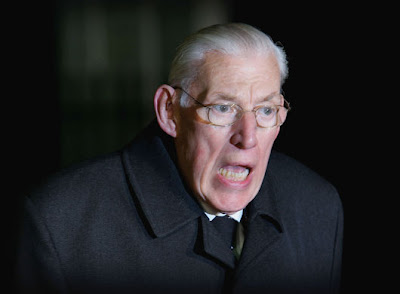



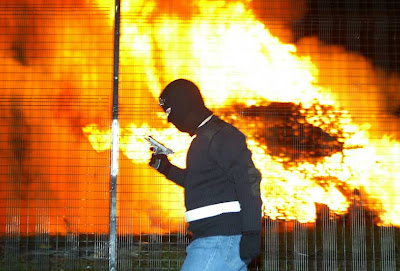




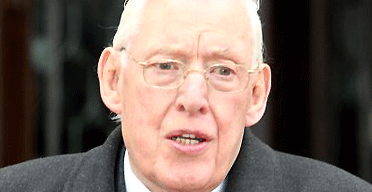
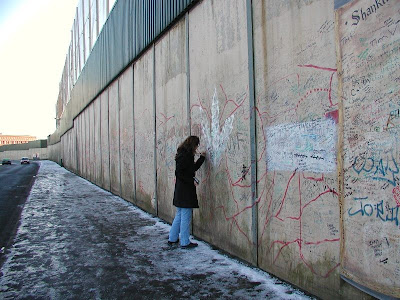

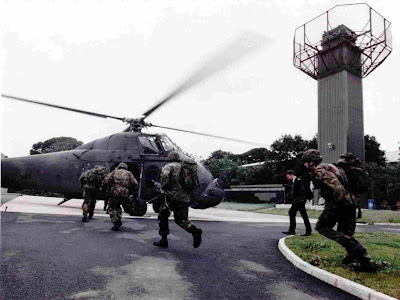



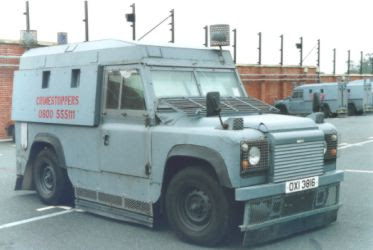

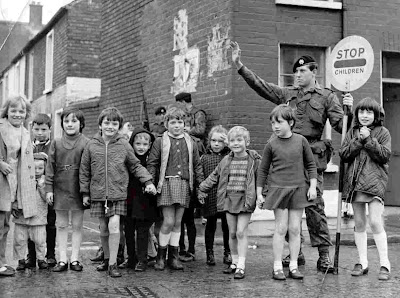
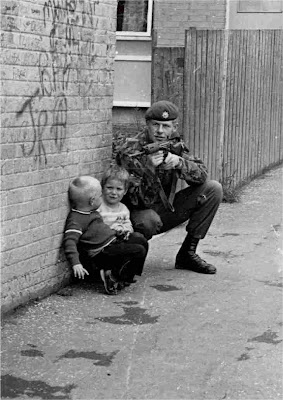


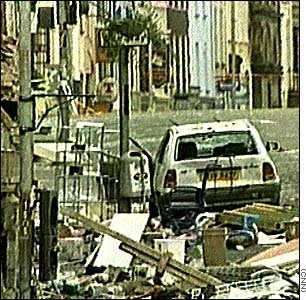



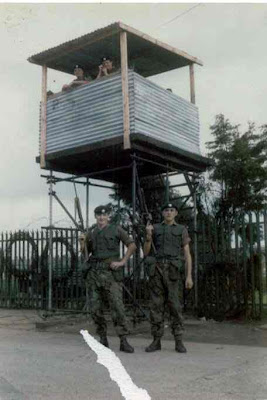
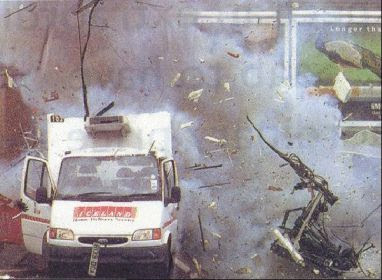


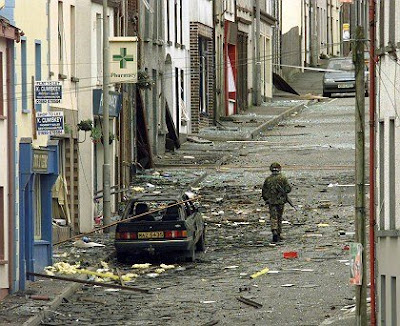
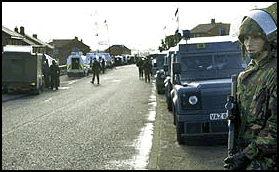
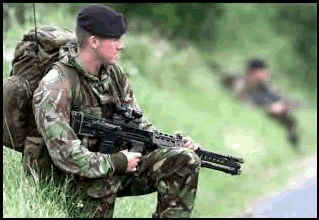



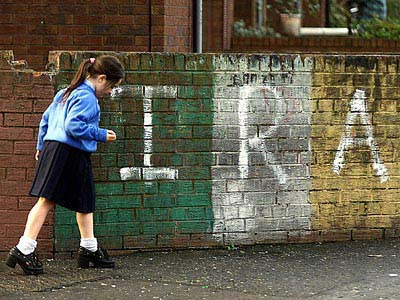




6 comments:
After all these years to see all those familiar faces again makes me feel very old indeed. Happy days in many ways but I certainly remember working very hard on that tour. I was in F troop at the time leaving for a very short attachment with the army air corps as aircrew on the lynx out of Dungannon before returning to finish the tour with the battery. Great piece of history you have written I hope it is never forgotten. Must go back there some day.
The M1 carbine, is actually a variant of a Springfield M14 rifle (7.62 NATO).
Hi would yu be interested in selling any of your photos from your tour in NI or your map that you drew? Thanks If so just leave a reply and I will send you my email address
A very interesting read. I was based in Aughnacloy and it was interesting to see the pictures and to reed your accounts of patrols. I was there in 1990 and it appears many things changed in how the Army carried out these patrols. Lessons learnt by mistakes I guess.
Very interesting reading. My father was based at the Customs Post at Aughnacloy from 1980 to 1995. Army bands used to regularly march in the town, he was a big fan of military music.
I don't know who wrote the blog but I do know that it is customary and good manners to credit the photographer, if you're going to use his photos. Most of these photos are mine.
Post a Comment